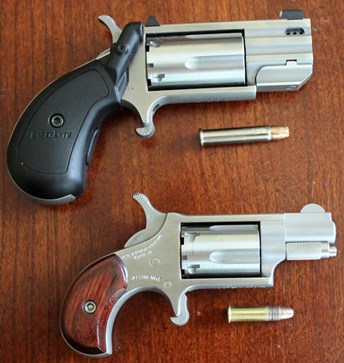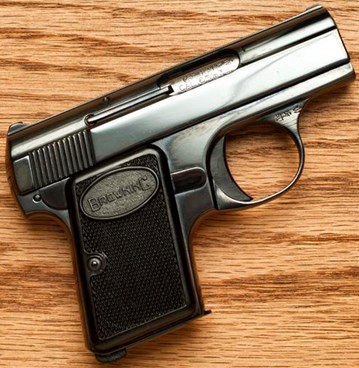
Recently American Rifleman's Brian Sheetz posted a video about the Beretta 21A Bobcat , a pocket-sized semi-automatic .22 LR with a tip-up barrel for easy loading. The review caught my attention because I once owned the INOX (stainless steel slide) version that I traded away as part of some other gun purchase. In the course of his review, Brian refers to the Bobcat as a “mouse gun.” It's a term that's not heard all that often these days but it was in common circulation back in the mid 1990s when I began to research concealed-carry handguns in earnest.
Generally speaking, defensive handguns can be grouped together by size: large (duty or full-size), medium (compact), small (sub-compact) and extra-small (pocket pistols). Mouse guns are a subset of the Pocket Pistol category chambered in pistol calibers smaller than .380 ACP, even though the .380 was once considered mouse-size until it went main stream (more on that later). Critics of small-caliber pocket pistols have been quoted as saying things along the lines of, "A pistol like this may be able to stop a charging mouse at three paces, but it's not much good for anything else." Thus the title of Mouse Gun was born.
After watching the video, I looked around online to see how much a Bobcat costs these days. Even though they are listed as being in production, I couldn't find one in stock at any of the usual sites I frequent. An expanded search showed that the majority of mousers I could think of off the top of my head were missing as well.
This left me with a few questions that I thought were worth exploring. If mouse guns have always been less than optimal for personal protection, why have so many folks chosen to carry them? If they are a dying breed, why is the population shrinking now after decades of regular sales? And what does the future hold for these littlest of defensive pistols?

The number one attraction to mouse guns has always been their size. They simply fit into pockets, purses and places where larger guns do not. This sacrifice of performance for pocketability is nothing new. Henry Deringer introduced the original single-shot muzzle loading percussion cap Philadelphia Deringer in 1852. By 1866 Remington had introduced the Model 95 chambered in.41 rimfire. In 1906 Fabrique Nationale de Herstal launched the FN Browning M1905 .25 ACP Vest Pocket Pistol chambered in the .25 ACP (6.35×16mmSR) cartridge.

Although a variety of mouse guns have been available for well over a century now, the calibers that were still in regular production around the beginning of this century include the .32 ACP, .25 ACP, .22 LR. and, occasionally, the .22 Short (such as the optimistically named Beretta 950 Jetfire and the NAA-22S Mini Revolver). The .22 Short is all but forgotten now, so let’s look at the other three calibers.

From left: .22 Short, .22 LR, .25 ACP, .32 ACP, .380 ACP, .380 ACP hollow point, 9mm, .38 Spec.
Mouse guns chambered in .22 LR have always been, and ever will be, designed specifically for inexpensive practice and mild levels of felt recoil. Budget priced pistols of dubious quality used to be fairly common, but many of the companies that produced them are now just footnotes in gun production history. Although .22 LR is potentially lethal when fired from any platform, it was designed primarily for use in rifles. As a result, the cartridge experiences a significant drop in performance when fired from pistols with stubby barrels of 2" or less. This drop in performance, along with an exceptionally broad range of ammunition power levels, makes .22 caliber semi-auto mousers among the most finicky eaters on the market.

Taurus still offers the tip-barrel 22 Poly but the company’s other .22 and .25 caliber models have been discontinued. The one mouse gun design that runs reliably with a variety of rimfire ammunition is the North Amercian Arms (NAA) series of Mini revolvers which are available chambered in .22 Short, .22 LR and .22 Mag. The slightly larger Magnum frames can be fitted with .22 LR conversion cylinders.

John Browning, the famous inventor of the 1911 pistol, designed the .25 ACP (6.35×16mmSR) semi-rimmed pistol cartridge in 1905 for his early blow-back operated vest pocket pistols which lacked a breech locking mechanism. Shown here is a Belgian Baby Browning manufactured in 1968 which I managed to rescue a few years back. Like the .22 caliber mouse guns, bushel loads of low quality .25s made from mysterious-alloys have been cranked out over the years. Unfortunately, they were hit and miss in the accuracy and reliability departments. However, the Browning pistols, along with the tip-barrel Beretta design and some of its better clones, have proven to be to be utterly reliable.

The .22s and .25s ruled the pocket pistol roost until the arrival of the L.W. Seecamp Co. stainless steel LWS-32 chambered in .32 ACP in 1985. This pistol was a slightly larger version of the company's slicked down, no sights LWS-25 chambered in .25 ACP. The .32 ACP cartridge provided a marked increase in performance potential while remaining exceptionally small and easy to carry. The LWS-32 was released right around the same time that the trend of states offering residents shall-issue concealed-carry permits was beginning to pick up steam (Maine, North Dakota, South Dakota and Florida switched to shall-issue permit between 1985 to 1987).

The Seecamp was the first of what I respectfully refer to as the .32 ACP "Rat Pack" which arrived on the market between 1985 and 1999. The .32s are still considered mouse guns by most but they do provide a marked increase in performance when compared to the .22 and .25 caliber mouse guns.

By 1996 another 21 states were offering shall-issue permits. Beretta followed Seecamp’s example of enlarging on an existing design with the release of the 3032 Tomcat, a .32 ACP tip barrel semi-auto which took its design cues from the Bobcat. It captured plenty of press and sold well.

North American Arms went head-to-head with the LWS-32 and the Tomcat in 1997 with the release of the NAA Guardian .32 ACP. Inspired by the Seecamp design, the Guardian features an all stainless steel construction, iron sights and a magazine well that was enlarged just enough to accept cartridges topped with full-metal jacket bullets as well as hollow points. The Guardians cost less and NAA was able to produce them more quickly.

Kel-Tec rounded out the pack with the release of the polymer-framed P32 in 1999. The P32 was, and still is, the slimmest and lightest offering in the Rat class with an unloaded weight of just 8 oz. It's so light and compact that some companies have made neck lanyard holsters for it.

As we reached and passed the turn of the new century, improved manufacturing technologies and a growing demand for more potent portable pistols led to the rise of the now ubiquitous .380 ACP pocket pistol. North American Arms had the NAA-380 Guardian on the market by 2001 followed by the Kel-Tec P-3AT in 2003. But it was the tidal wave success of the Ruger LCP release in 2008 that inspired many other companies to make ultra-compact, light weight .380s of their own, most of which are still for sale today.
With the .380 ACP firmly established as the preferable pocket option for modern self defenders, the fastest growing category of concealed carry pistol in recent years has been the single-stack 9mm semi-autos. Although most of these models are sub-compacts, their increased power factor has worked in tandem with the .380 ACPs to push most mouse guns out of production.
So what does the future hold for mouse guns? As far as new production goes, the .22s and .25s are all but gone and many defensive hand gun instructors are saying good riddance. However, the Rat Pack .32 ACPs are still in business with the NAA Guardian and Kel-Tec P32 remaining the most popular. The NAA Mini revolvers are also selling well, especially the .22 Mag. version. What about all of the thousands of mouse guns manufactured before now? Since guns don't have an expiration date and will continue to operate for decades if properly cared for, I suspect they will continue to be carried by those owners who prefer them.

In regard to whether folks should pack a mouse gun for personal protection, here's my rule of thumb for selecting a concealed-carry gun: The distance at which I can consistently print defensively adequate 5-shot groups around 3” in size, from a standing position, is the maximum distance at which I’m going to trust the gun-caliber-operator combination to be effective in a defensive situation. Some handguns are 25-yd. guns when I’m pulling the trigger while others are only 15-yd. or 7-yd. The handsome little Baby Browning .25 ACP is exceptionally well made and utterly reliable but the small slick grip and ornamental sights make it a 4 to 5-yard gun, at best, when it’s in my hands.
Taking the time to identify these operational limitations has served me well in pulling together a self-defense plan. Certain guns have been promoted to primary carry status, others to the back-up gun slot and some have been shelved or traded out, like the Beretta Bobcat 21A Inox mentioned at the start of this article. I wish I still had it because it's a sleek example of the shrinking mouse gun category that I may never be able to replace. But if I ever do get another one, it will go in the safe next to the Baby Browning.

Additional Reading:
Bond Arms: Building the World's Smallest 10 mm Pistol
Sorting Out the Littlest Brownings
Pocket Pistols Past and Present
6 of the Smallest Handguns on the Market Today
7 Tips for Pocket Carry
15 Top Pocket Holsters
7 Ways to Make Pocket Pistols Work for You





































